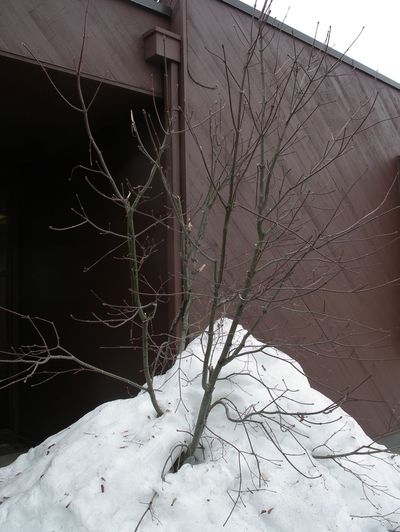Wait to dig limbs, branches out of snow

It was pretty at first but that Cascade concrete now covering our gardens is hiding a major problem; broken and smashed shrubs and small trees that we won’t know about until it all melts.
While most of the larger trees seemed to do pretty well with the snow loads, shrubs and small trees that are still buried may not be so lucky. To add insult to injury, plants around buildings may have been dealt a second blow when the roofs above them were shoveled off adding to the icy load. As a result, we may be dealing with a lot of broken branches when they emerge from the ice.
Resist the urge to dig the plants out or try to pull branches out of the ice. Just wait until it melts. The wood is brittle in the cold and will break easily. Secondly, the branches are tangled up under the snow. Pulling will only make matters worse. Keep in mind that most plants here are used to snow loads and will resume their shape without help.
As they do emerge, check carefully for damage. Remove the obviously broken branches with sharp pruning tools. Other branches and trunk crotches may be only cracked and damage to these may not show up until later in the spring. Cut back any broken limbs to a limb below the break with an eye to maintaining the shrub or tree’s shape. More pruning may be needed in the next few years to restore the plant’s shape.
Restorative pruning on shrubs is going to depend on the variety of shrub and its growth habit. If you don’t know what you have, wait until the leaves come out and get them identified at a local nursery. Some plants can be cut down heavily and will come back while others won’t. Junipers in particular will not regrow if cuts are made into the old wood under the green needles. Others like rhododendrons and lilacs should not be trimmed until right after they bloom.
Many arborvitaes, boxwood and other tall upright evergreens were splayed out by the snow loads. Unfortunately, once this happens, the plants may not resume their shape without help, if at all. They can be pulled back together with a spiral wrap of heavy twine or light rope. Use a synthetic material as natural materials like hemp and sisal will rot after a few years. In some cases, the plants may be too badly bent and will need to be replaced. Finding a replacement for large plants will be difficult and expensive.
If all this seems a bit much and you decide to hire the work out, be sure you get reputable people who know their plants and will take the time to prune plants correctly. Ask for references from previous years. Be willing to pay a fair price. You will spend the money on a good pruning job or you will spend it replacing the plants.